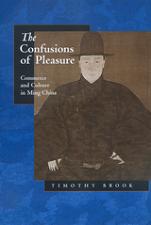Finance:The Confusions of Pleasure
 Front cover of The Confusions of Pleasure | |
| Author | Timothy Brook |
|---|---|
| Country | United States |
| Language | English |
| Genre | History |
| Publisher | University of California Press |
Publication date | 18 May 1998 |
| Media type | Print (Hardback) |
| Pages | 345 |
| ISBN | ISBN:0-520-21091-3 |
The Confusions of Pleasure: Commerce and Culture in Ming China is an influential[1] and frequently cited[2] book which explores the economic and cultural history and the "influence of economic change on social and cultural life"[3] in China during the Ming dynasty (1368–1644).[4] The book is written by Timothy Brook, a Canadian[5] historian of China (Sinology).[6] The work won the Joseph Levenson Book Prize of 2000.
Synopsis
The book is organized chronologically, with four sections named after seasons: Winter (1368–1450), Spring (1450–1550), Summer (1550–1642) and Fall (1642–1644).
Reception
Writing for Economic History Services, Richard Lufrano of the College of Staten Island, City University of New York (CUNY), states that the book "provides an eloquently written and comprehensive account of commerce and communication in Ming China especially valuable for scholars working on related questions in other geographical areas. For the specialist, as well as others, the book makes a fundamental contribution by offering a more balanced view of how money and the market economy affected social hierarchy, elite status, and social mobility."[3]
In his review, Danny Yee concludes that "the result is in some ways scattered, but individual sections cohere and the overall effect is that of a mosaic, a multi-faceted picture of Ming China." Describing the writing as "easy reading" and "lively prose", he states that the book "will be a gold-mine for those curious about the historical underpinnings of Chinese commercial traditions", and "recommended to anyone curious about other ways of viewing the world."[7]
Notes
- ↑ "Whispers of ancient times speak volumes for history". The Times magazine. 26 November 1999. http://www.timeshighereducation.co.uk/story.asp?storyCode=157519§ioncode=22. Retrieved 2010-01-25. Passim, but states that the book is "now-influential": "... The volume does not lack important insights into social aspects of these topics. Most notable are those of Timothy Brook, whose chapter on communications and commerce provides a welcome amplification of his now-influential cultural history of the Ming, The Confusions of Pleasure."
- ↑ See citations at Google scholar search
- ↑ 3.0 3.1 Lufrano, Richard (August 1998). "Book Reviews: The Confusions of Pleasure: Commerce and Culture in Ming China". Economic History Services. Archived from the original on January 8, 2009. https://web.archive.org/web/20090108124327/http://eh.net/bookreviews/library/0117. Retrieved 2010-01-25. Reviewed by Richard Lufrano, College of Staten Island, City University of New York (CUNY).
- ↑ Clunas, Craig (4 December 1998). "Learning to shop in Ming China". Times Higher Education Supplement. http://www.timeshighereducation.co.uk/story.asp?storyCode=161043§ioncode=22. Retrieved 2010-01-25.
- ↑ Dirda, Michael (27 January 2008). "Painting the World: How a hunger for tea and tobacco created global trade.". Washington Post. https://www.washingtonpost.com/wp-dyn/content/article/2008/01/24/AR2008012402715.html. Retrieved 2010-01-22.
- ↑ Conrad, Peter (29 June 2008). "A time when every picture told a story". The Observer. https://www.theguardian.com/culture/2008/jun/29/review.features1. Retrieved 2010-01-22.
- ↑ Yee, Danny (2005). "The Confusions of Pleasure: Commerce and Culture in Ming China". dannyreviews.com. http://dannyreviews.com/h/Confusions_Pleasure.html. Retrieved 2010-01-24.
Foreign translations
- (in Czech) Čtvero ročních dob dynastie Ming: Čína v období 1368-1644. Prague: Vyšehrad, 2003.
- (in Chinese) Zongle de kunhuo: Mingdai de shangye yu wenhua. Beijing: Sanlian, Taipei: Linking, 2004.
- (in Korean) K'waerak ǔi hondon: Chungguk Myǒngdaeǔi sangǒp kwa munhwa. Seoul: Yeesan, 2005.[1]
Further reading
Other reviews
- Dardess, John W. (Winter 1999). "The Confusions of Pleasure: Commerce and Culture in Ming China (review)". Journal of Interdisciplinary History (The MIT Press) 30 (3): 562–563. doi:10.1162/jinh.1999.30.3.562. http://muse.jhu.edu/login?uri=/journals/journal_of_interdisciplinary_history/v030/30.3dardess.html. Retrieved 2010-01-25. E-ISSN 1530-9169 Print ISSN 0022-1953.
- Macauley, Melissa (December 1999). "The Confusions of Pleasure: Commerce and Culture in Ming China". The Journal of Economic History (Cambridge University Press) 59 (4): 1106–1107. doi:10.1017/S0022050700024311. http://journals.cambridge.org/action/displayIssue?jid=JEH&volumeId=59&issueId=04&iid=4167836. Retrieved 2010-01-26.
External links
 |
- ↑ Staff (c. 2008). "The Department of History at University of British Columbia: tim-brook". University of British Columbia. http://www.history.ubc.ca/tim-brook/. Retrieved 2010-01-29.

